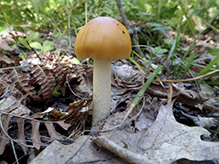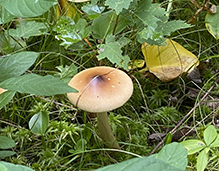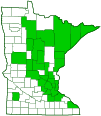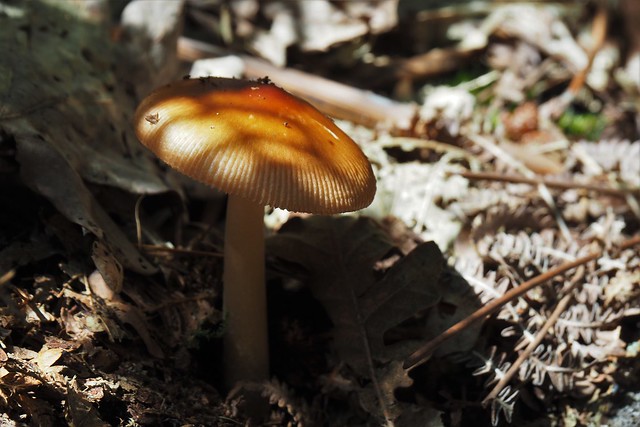Tawny Grisette
(Amanita fulva)
Conservation • Description • Habitat • Ecology • Distribution • Taxonomy
|
|
||||||||||||||
Description |
Tawny Grisette is a common, medium-sized, gilled mushroom. It occurs in Europe, Japan, and North America. It occurs in the United States and southern Canada east of the Great Plains and in the Pacific Northwest. It is relatively common in eastern Minnesota but it is mostly absent from the western half of the state. It is found in the summer and fall, alone, scattered, or close together but not clustered (gregarious), in deciduous and mixed woodlands. It grows on the ground near trees. It has a mutually beneficial relationship (mycorrhizal) with the tiny rootlets of hardwood and coniferous trees, absorbing sugars and amino acids while helping the tree absorb water. The cap is oval, orangish-brown to tawny or tan, and sticky at first. As it ages it spreads out, becoming broadly convex. The mature cap is 1½″ to 4″ (4 to 10 mm) in diameter and flat, sometimes with a raised bump in the middle (umbonate). It is usually darker, often very dark, in the middle. The margins are prominently lined or grooved (striate). The surface is dry but becomes slightly slimy when wet. It is usually bald but rarely there are a few scattered whitish fragments of the universal veil clinging to the cap. The stalk is 2¾″ to 6¼″ (7 to 16 cm) long, 3⁄16″ to ⅝″ (5 to 15 mm) thick, and slightly tapered to the top. It is slender, hollow, fragile, hairless or slightly hairy, and whitish or tinged the color of the cap. There is no ring. The base is loosely enclosed in a cup-like sac (volva) that is the persistent remains of the universal veil. The volva is white and often develops tawny brown blemishes. The gills are closely spaced to nearly crowded and are narrowly attached to the stalk (adnate) or not attached (free). They are white or whitish, becoming pinkish in old age. There usually are no secondary, short gills between the main gills. The flesh is thin, white, and soft. It does not discolor when sliced. Unlike most Amanitas, it is edible when cooked. However, eating it is strongly discouraged due to its similarity to highly poisonous species. The spore print is white. |
Similar Species |
| Grisette (Amanita vaginata) cap is gray to grayish-brown. There are plentiful short gills. |
Habitat and Hosts |
Woodlands. Hardwood and coniferous trees. |
Ecology |
Season |
Summer and fall |
Distribution |
||
|
Sources Biodiversity occurrence data published by: Minnesota Biodiversity Atlas (accessed through the Minnesota Biodiversity Atlas Portal, bellatlas.umn.edu, XX/XX/XXXX). |
|
Occurrence |
||
|
||
Taxonomy |
|
Kingdom |
Fungi (Fungi) |
Subkingdom |
Dikarya |
Phylum |
Basidiomycota (Basidiomycete Fungi) |
Subphylum |
Agaricomycotina (Higher Basidiomycetes) |
Class |
Agaricomycetes (Mushrooms, Bracket Fungi, Puffballs, and Allies) |
Subclass |
Agaricomycetidae |
Order |
|
Suborder |
Pluteineae |
Family |
Amanitaceae (Amanita mushrooms and allies) |
Tribe |
Amaniteae |
Genus |
Amanita (Amanita mushrooms) |
Subgenus |
Amanita |
Section |
Vaginatae |
Subordinate Taxa |
|
|
|
Synonyms |
|
Agaricus fulvus Amanita vaginata var. fulva Amanitopsis fulva Amanitopsis vaginata var. fulva Vaginata fulva |
|
Common Names |
|
Orange-brown Ringless Amanita Tawny Grisette |
|
Glossary
Mycorrhizal
A symbiotic, usually beneficial relationship between a fungus and the tiny rootlets of a plant, usually a tree.
Striate
Striped or grooved in parallel lines (striae).
Umbonate
On mushrooms, having a distinct, raised, knob-like projection in the center of the cap.
Universal veil
An egg-like structure that envelopes all or most of a developing gill mushroom. Remnants of the universal veil sometimes visible on a mature mushroom are patchy warts on the cap, a ring on the stalk, and a volva at the base of the stalk.
Volva
Also called cup. A cup-like covering at the base of a mushroom stem, sometimes buried. In Amanita, Volvariella, and some other mushrooms, it is the remnants of the universal veil ruptured by the mushroom pushing through. In Phallales it is the remnants of the ruptured peridium.
Visitor Photos |
||
Share your photo of this fungus. |
||
This button not working for you? |
||
Dan W. Andree |
||
Another Mushroom... These were seen at Frenchman's Bluff SNA recently in a low area between to large hills. |
||
 |
 |
|
 |
 |
|
 |
 |
|
Luciearl |
 |
Sandy Jacoby |
 |
MinnesotaSeasons.com Photos |
||

Visitor Videos |
||
Share your video of this fungus. |
||
This button not working for you? |
||
|
Other Videos |
||
Identifying edible fungi: Amanita fulva - tawny grisette. |
About
Jul 1, 2021 |
Amanita fulva Tawny Grisette 4k |
About
May 30, 2020 Amanita fulva By: Manu Merino Here I present you a beautiful and curious amanita, since a difference from most of the amanitas, that one does not have a ring. Cooked it is edible and in some countries much appreciated. But I also have to be very careful, since it belongs to a family where the most fatal mushroom is found, the Amanita phalloides. The video of the species is recorded in August 2019, along with other nature scenes recorded this May 2020. Amanita fulva p. 1815 Characteristics: -Cap: Medium in size, usually measuring between 4 to 8 cm in diameter. At the beginning it is ovoid, and at the end it is convex with a central umbo. The cuticle is shiny, moist, smooth with a fluted and ribbed margin of a nice tawny to orange-brown color with different shades. -Sheets: Whitish, free, little tight and with lamélulas - Stem: Long, slender, cylindrical, wider at the base, hollow, a little brindle or flocky, whitish in color with fawn tints. Without a ring, an important difference compared to other amanitas and with a high and wide volva, white with reddish brown tones. - Flesh: White, fragile, with a pleasant taste and a slight odor, - Edibility: Raw is toxic, but cooked is appreciable although it is not popularly valued -Habitat: It usually appears in forests of planifolia, beech, oak, chestnut, but curiously the species in the video have emerged in a small birch forest. -Place: Urkiola Natural Park Confusions: Not having a ring, you have to be very careful as it could be confused with other mortals such as A. Phalloides with greenish hat color. I hope you liked the video of this species, and for that I thank you for the visit and the support of the channel. |
Rhode Island Amanita Series: Amanita fulva |
About
Aug 17, 2021 |

Visitor Sightings |
||
Report a sighting of this fungus. |
||
This button not working for you? |
||
Dan W. Andree |
Location: Frenchman’s Bluff SNA These were seen at Frenchman's Bluff SNA recently in a low area between to large hills. |
 |
Luciearl |
Location: Cass County |
 |
MinnesotaSeasons.com Sightings |
||
|

Created: 8/31/2022 Last Updated: © MinnesotaSeasons.com. All rights reserved. |


